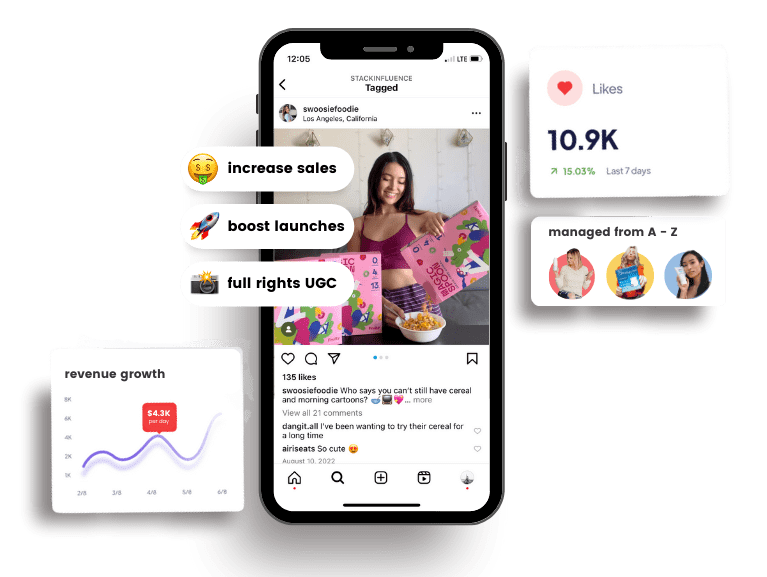7 Ways to Get Customer Reviews
8th
October, 2025
Influencer Marketing
Amazon Marketplace
Artificial Intelligence
TikTok Tips
Think about the last time you shopped online. Did you check the reviews before clicking “Buy”? If you’re like roughly 90% of consumers, the answer is yes – and nearly as many people trust online reviews as much as personal recommendations. Having plenty of genuine customer reviews isn’t just nice-to-have; it’s crucial for e-commerce brands to build trust. In fact, over half of shoppers read 2–6 reviews before feeling confident in a business or product (only ~3% will trust just a single review). Shoppers are far more likely to choose an item with many positive reviews over one with only one or two, even if that lone review is 5 stars. In other words, a lack of reviews can be a red flag that makes your product seem untested or “sketchy”. So how can brands (especially Amazon sellers and small businesses) gather more authentic feedback?
One of our competitors, Aspire, recently shared “9 creative ways to get customer reviews.” We’ve taken inspiration from their ideas but put our own spin on it. Below are 7 effective strategies to encourage more customers to leave reviews – from leveraging micro-influencers to simply asking nicely. (And don’t worry, none of these involve buying fake reviews!)
1. Partner with Micro-Influencers & Creators for Authentic Reviews

In today’s competitive e-commerce world, brands (from boutique sellers to big Amazon vendors) are turning to micro‑influencers and content creators to help generate authentic buzz. Micro-influencers are niche creators with dedicated followings; their shout-outs feel like friendly recommendations and often lead to user-generated content (UGC) such as testimonials, social posts, and credible product reviews. This content can be a goldmine – you can repurpose an influencer’s post or Instagram caption mentioning your product as a customer story on your site, or quote their feedback in your emails, adding third-party validation to your marketing. The beauty is that these reviews come off as organic and genuine, since they’re voiced by real people who genuinely tried the product.
Collaborating with micro-influencers can also directly drive new customer reviews. For example, you might send a free product to a group of micro-influencers or content creators in your niche and have them share their honest experience on social media. Their followers may then try the product and leave their own reviews as well, creating a ripple effect of fresh feedback. For Amazon sellers in particular, this strategy can be powerful – an influencer’s followers who buy your item often end up leaving reviews on your Amazon listing, boosting your review count (and even your search ranking) in the process. In essence, micro-influencer campaigns not only produce great UGC, but also funnel in new customers who contribute more reviews and ratings for your brand. Using a specialized platform like Stack Influence can streamline this process by connecting you with an AI-vetted network of micro- and nano-influencers in your target market. It’s a cost-effective way to scale up word-of-mouth: you get authentic reviews and content, they get free products or small fees – and everyone wins with more trust all around.

Unlock the Power of Micro Influencers and Elevate your Brand Today!

2. Launch a Dedicated “Review Campaign”
Don’t just wait and hope for reviews to appear – sometimes you need to kickstart the process with a campaign. This could be a one-off initiative focused on generating reviews in a short time frame. For example, run a campaign where you send free product samples to a select group of customers, brand ambassadors, or even employees and follow up after a week or two asking for their honest review. The idea is to actively solicit feedback when the product experience is fresh. You can frame it as an exclusive trial or a thank-you program for loyal community members so it feels special. Make sure to emphasize that any feedback is welcome – positive or negative – since authentic and balanced reviews build credibility. (In fact, a mix of five-star and a few moderate reviews looks more trustworthy to shoppers than a page of all 5-star raves.) By creating a dedicated “review generation” campaign like this, you can quickly accumulate testimonials. Just remember to keep it ethical: you’re asking for reviews, not outright paying for positive ones.
Another approach is to incorporate review requests into your regular marketing campaigns. For instance, an email campaign after product delivery can double as both a thank-you and a gentle nudge for a review. You might design a fun challenge (e.g. “30 Reviews in 30 Days” drive) on social media, encouraging customers to share a quick review for a chance to be featured. The key is to make participants feel like insiders helping out a brand they love. By organizing a campaign around reviews, you set a clear goal and generate excitement around giving feedback, rather than leaving it as an afterthought.
3. Encourage User-Generated Content and Co-Creation
Let’s face it: people are busy and sometimes need a little push to take the time to write a review. Offering a small incentive can be a great motivator – as long as you do it the right way. There’s a big difference between buying reviews (unethical and often against policy) and rewarding customers for sharing their honest feedback. The goal is not to bribe for five-star reviews, but to show appreciation for those who take the time to help your community with their input. For example, you might send an email to recent buyers letting them know that if they leave an online review, they’ll earn a perk like a discount on their next purchase or entry into a giveaway contest. Be sure to make it easy – include a direct link to your preferred review platform or product page in the email so they can quickly click and submit feedback.
Here are a few incentive ideas that work well for e-commerce brands:
-
-
- Loyalty points or discounts: If you have a customer loyalty or VIP program, give a small points bonus, coupon, or % off coupon for each verified review. This rewards reviewers and encourages repeat business.
- Exclusive access or freebies: Offer something like free samples, a downloadable guide, or early access to new products for customers who review. It makes them feel valued and part of an exclusive group.
- Shout-outs and spotlights: Highlight great customer reviews on your social media or website. For instance, post a “Review of the Week” on Instagram (with the customer’s permission). This public appreciation not only flatters the reviewer, but also inspires others to share their experience in hopes of being featured.
- Contest entries: Periodically hold a raffle or contest that people can enter simply by submitting a review. For example, “Review any product this month and be entered to win a $100 gift card.” Contests are fun and can generate a surge of new reviews in a short time.
- Loyalty points or discounts: If you have a customer loyalty or VIP program, give a small points bonus, coupon, or % off coupon for each verified review. This rewards reviewers and encourages repeat business.
-
Note: Always check the rules on platforms you care about (Amazon, Google, etc.) – some strictly prohibit incentivized reviews or have specific guidelines. The incentive should never hinge on the review being positive. When done ethically, rewarding reviewers shows that you value customer feedback and can dramatically increase review volume.
4. Make Leaving Reviews Easy (Post-Purchase Prompts)
Sometimes the biggest barrier to getting reviews is simply customer effort. The easier and more convenient you make the review process, the more likely you’ll collect feedback. One effective tactic is implementing a post-purchase review prompt – strike while the iron is hot! This could take the form of a quick post-checkout survey or automated email asking “How was your experience?” right after the customer receives the product. Timing is everything: customers are most inclined to respond when the interaction is fresh in their mind. For example, an e-commerce store might email a buyer 3–5 days after delivery (once they’ve had a chance to use the product) with a friendly request to rate and review their purchase. Include a direct link to the product review page or a built-in review form in the email. By removing friction (no need for the user to hunt down your product on a review site), you’ll get far more submissions.
Another easy-win is to embed review requests into your website/app. After an online purchase, redirect customers to a “Thank You” page that asks them to rate their shopping experience with a few stars or a short comment. If you have a mobile app, send a push notification asking for feedback shortly after purchase or delivery. You can also use QR codes on product packaging or receipts that take customers straight to a review form with one scan. Many e-commerce brands now rely on a Dynamic QR code generator to create scannable links that can be updated or tracked over time, helping them analyze how customers interact with post-purchase prompts. Even a one-sentence review or a star rating is valuable. By integrating effortless review opportunities into the customer journey (and maybe reminding them once or twice, as needed), you’ll significantly increase your review count without annoying users. It’s all about meeting customers where they are and saying “Got 30 seconds? We’d love your feedback!”
5. Just Ask – Especially Your Happy Customers
Sounds obvious, but it works: If you want a review, ask for it. Many shoppers will gladly share their opinion if you give them a polite nudge. Don’t be shy about reaching out to customers who’ve had a positive experience and personally asking for a quick review. For instance, if you have a customer that has made multiple purchases or someone who emailed your support with praise, that’s a great person to approach. Send a personal email or message thanking them for being a loyal customer (make it sincere and specific) and mention that you’d love to hear their feedback as a review. Loyal fans often feel flattered that you value their opinion enough to ask. By communicating one-to-one, you show that you truly care about their experience, which increases their brand loyalty and willingness to help out.
This strategy isn’t about spamming every buyer – it’s about identifying your brand advocates (the “superfans”) and engaging them. You might be surprised how many will respond with a glowing review just because you took the time to reach out personally. A few tips: keep your request short and heartfelt. For example: “Hi [Name], just wanted to personally thank you for being such an awesome customer. It makes our day to see you enjoying our products! If you have a moment, would you mind sharing a short review of your experience? It would help a lot of other shoppers. 🙂 Thanks again – we appreciate you!” A friendly note like that can go a long way. People love to feel heard and appreciated, so when they do leave a review, be sure to follow up with gratitude – a simple reply or email saying “Thanks for your feedback!” can make them feel great and reinforce that their review wasn’t just swallowed by a void. The easier and warmer you make the ask, the more success you’ll have turning happy customers into vocal advocates.
6. Monitor Brand Mentions and Leverage Niche Communities
Not all customer reviews will come through the official channels. There may be people out there already talking about your product on social media, forums, or niche review sites – you just have to find them. Taking a more proactive listening approach can uncover these organic reviews and even turn them into marketing assets. Start by setting up Google Alerts for your brand name and product names, as well as using social listening tools to catch mentions on Twitter, Instagram, TikTok, etc. Whenever someone mentions your brand or reviews your product in an unofficial capacity, engage with them. For example, if a customer tweets a compliment about your product, retweet it or thank them publicly. If someone writes a detailed blog post or Reddit comment reviewing your product, reach out to say you appreciate their insights. This shows that you’re paying attention beyond just the big platforms.
You can also repurpose these existing mentions to bolster your review content. Got a great tweet saying your service is amazing? With the author’s permission, screenshot it and add it to your website’s testimonials. Did a YouTuber casually review your product in a video? Ask if you can quote them or share the video on your site. Many content creators are happy to grant usage rights if you just ask. Don’t forget about niche review sites and forums in your industry – oftentimes enthusiastic users post reviews on these platforms that fly under the radar. Whether it’s a specialized site like an independent makeup review blog, a homebrew forum, or an Amazon product discussion, keep an eye out for talk about your brand. You can set alerts for those sites or do periodic searches. When you find positive feedback in these corners of the internet, show it off (again, grab a snippet or quote and display it on your product page or socials, giving credit to the source). By tapping into existing organic reviews and amplifying them, you not only get more mileage out of them but also encourage those authors – and others in their communities – to continue spreading the word. Plus, new customers will see that people everywhere (not just on your site) are saying good things about you, which hugely boosts trust.
7. Respond to Reviews and Engage with Your Customers

Getting customer reviews is step one; step two is showing up and engaging with those reviews. Believe it or not, how you handle existing reviews can influence future customers to leave their own. Shoppers pay attention to whether a brand is responsive and attentive. When people see that you reply to reviews – be it thanking someone for a glowing 5-star review or addressing a complaint with empathy – it humanizes your brand and builds trust. Importantly, it creates a two-way conversation that makes customers feel heard. In fact, responding to customer reviews (even bad ones) actually encourages more customers to write reviews, because they know you’ll read and value their input. No one wants to feel like their review vanishes into a black hole. Acknowledging feedback – good and bad – signals that you’re listening and care about customer satisfaction.
Make it a habit to respond promptly to new reviews. For negative or critical reviews, respond in a professional, understanding tone and offer to make things right if possible. This can turn an unhappy customer into a loyal one, and it shows onlookers that you take issues seriously. For positive reviews, a simple thank-you or a personalized comment about their experience goes a long way. Don’t only chime in when feedback is bad – celebrate the good reviews too! For example, if a customer raves that your product “changed their life,” respond with gratitude and maybe highlight a specific detail they mentioned (“We’re thrilled that our protein shake is part of your morning routine – thanks for the love!”). This level of engagement demonstrates that you’re not just doing damage control, but genuinely interested in all customer opinions. Some brands even go a step further: sharing or reposting excellent reviews on social media (with permission) to publicly appreciate their customers’ voices. By actively managing your reviews and interacting with reviewers, you create an environment where feedback is valued. Future customers will be more inclined to share their thoughts because they see it’s a conversation, not a one-sided rant. In short, be responsive – it builds loyalty with existing customers and motivates new ones to join the dialogue.

Unlock the Power of Micro Influencers and Elevate your Brand Today!

Conclusion to 7 Ways to Get Customer Reviews
Building up a robust base of customer reviews won’t happen overnight, but with these strategies you can steadily turn more buyers into vocal fans. Micro-influencers, loyal repeat shoppers, casual buyers – they all have a story to tell about your product. Encourage those stories through campaigns, incentives, and simple outreach, and always reward the effort by listening and engaging. Over time, you’ll cultivate a rich collection of testimonials that serve as social proof for your brand. This kind of user-generated content doesn’t just sit idly on your product page – it actively drives sales. Studies show that featuring customer reviews can dramatically boost conversion rates (one report found that adding reviews to product pages increased conversions by up to 3.5X!). More importantly, reviews build trust and community. Shoppers feel more confident purchasing when they see real people – people like them – vouching for a product.
In the age of AI search and savvy consumers, authentic reviews and UGC are becoming key differentiators for e-commerce success. By applying the tips above, you’ll not only gather more customer reviews, but also strengthen your brand’s credibility in the eyes of both search algorithms and everyday customers. So start that review campaign, reach out to your influencers and superfans, and watch the social proof snowball. Before you know it, your brand will be bursting with great customer reviews – and with happier customers, too, thanks to feeling heard.

By William Gasner
CMO at Stack Influence
William Gasner is the CMO of Stack Influence, he's a 6X founder, a 7-Figure eCommerce seller, and has been featured in leading publications like Forbes, Business Insider, and Wired for his thoughts on the influencer marketing and eCommerce industries.
Want new articles before they get published? Subscribe to our Awesome Newsletter.
stack up your influence
turning creativity into currency
our headquarters
111 NE 1st St, Miami, FL 33132
our contact info
[email protected]
stack up your influence
turning creativity into currency
our headquarters
111 NE 1st St, 8th Floor
Miami, FL 33132


